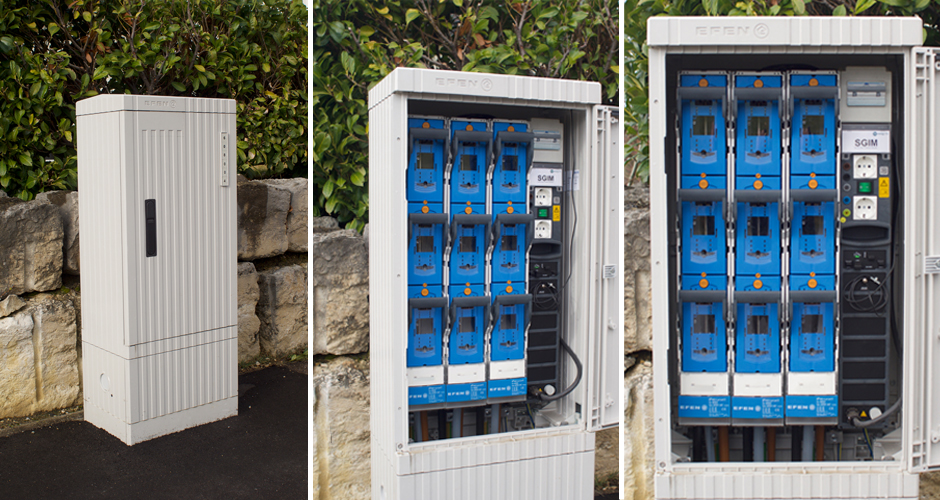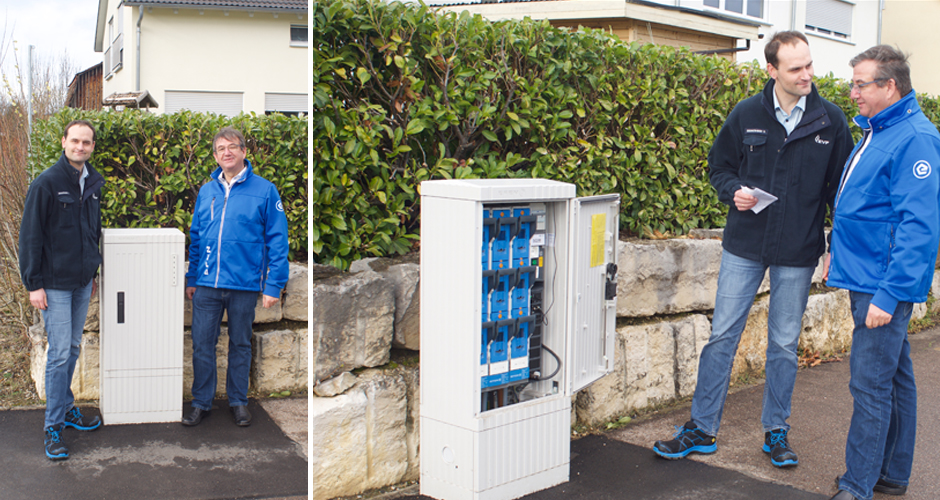 gekennzeichnet.
gekennzeichnet. gekennzeichnet.
gekennzeichnet.Local electrical grids must primarily ensure the security of supply of the connected electricity customers. During planning, however, it is still important not to oversize the grid in order to avoid unnecessarily high costs. If a customer then calls up significantly more power than contractually agreed, this can easily lead to overloads and, as a result, to a reduction in quality. The energy supplier Filstal from Göppingen, Germany, therefore uses EFEN measurement technology directly in the distribution cabinet.
Increased feed-in from renewable energy sources and the establishment of charging infrastructure for electromobility are just two of the most important challenges energy suppliers are facing. In the past, distribution grids, including those based on local grids in the low-voltage range, were not designed for such applications.
To meet the new challenges for distribution grids, they need to become smart. „The future in local grids will be the smart grid,“ Daniel Eisenhuth-Maier is certain. The group leader in the low-voltage area at Energieversorgung Filstal GmbH & Co. KG (EVF) in Göppingen is responsible for grid operation and ensures the reliable supply of electrical energy for around 40,000 customers. EVF has been operating the electrical supply grid since 2014, including the medium and low-voltage grid with three transformer stations and over 400 local grid stations. The medium-sized company, which employs a total of around 200 employees, is also active in the fields of gas supply, district heating, internet and telecommunications.
„Over the past few years, the requirements placed on our distribution grids have changed dramatically,“ says D. Eisenhuth-Maier: „The strong expansion of charging stations for electromobility in particular can push the existing infrastructure to its limits.“ In order to adapt the distribution grids in the low-voltage range optimally and purposefully, a basic prerequisite is absolutely essential: The exact knowledge of the load flows in the distribution grids. „We have to use more and more measurement technology in the grids – because in order to control something, I first have to be able to measure it,“ says D. Eisenhuth-Maier in a nutshell.
However, there are also other challenges in the low-voltage grid of EVF in Göppingen. For example, a commercial enterprise has repeatedly exceeded the limit values for the electrical power drawn.“ Although only 100 A were contractually agreed, in some cases there were peak currents of up to 300 A,“ recalls D. Eisenhuth-Maier: „Often, the customer is not aware that large capacities are subject to registration.“ In this specific case, the fact that the connection was quite distant from the local grid transformer made things even more difficult. As a result, the large power peaks led to a deterioration of the grid quality in the area surrounding the commercial enterprise. As a result there was a drop below the voltage band.
One measure that the EVF team implemented was a change in the grid connection and the conversion to a more powerful transformer. While this solved the problems on short notice, EVF has been looking for a solution to detect such situations early in the future in order to be able to react accordingly. This requires the exact measurement of the grid parameters directly in the local grid distributors. The team of D. Eisenhuth-Maier found a suitable system for this measurement task with the Smart Grid Interface Module (SGIM) by EFEN.

EVF purchased the cable distribution cabinet as a complete system from EFEN. The size 00 cabinet with 185 mm busbar system already contains three size 2 NH fuse switch-disconnectors from the EFEN E3 series with integrated current transformers. The insert transformers specially developed for these strips can be easily attached to the rear of the NH fused isolator. The modular SGIM has the same width as the switch-disconnector-fuses and therefore fits perfectly into the reserve space of the cable distribution cabinet. It is powered directly via the busbar system. In addition to a power supply unit and the controller of the SGIM, a module for the connection of the current transformers is installed. Another slot is equipped with a communication module. This is used to transfer the data to a cloud based server via mobile communication. „We sent a mobile phone SIM card to EFEN before delivery, so that it was already installed beforehand“, says D. Eisenhuth-Maier. Therefore, after installation and connection of the new cable distribution cabinet the data transmission and evaluation could be started immediately. The basic equipment of the SGIM also includes two Schuko sockets, which can be used to supply an additional device with power during maintenance work. Due to its modular design, the SGIM can be easily expanded with additional measuring modules.
EFEN’s complete package also includes a cloud platform on which the data is made available for evaluation. All measured values are transmitted directly after commissioning. In addition to currents, the SGIM also calculates the important grid parameters such as reactive, apparent and active power, energy consumption, power factor, phase angle as well as grid frequency. For data transmission, the SGIM uses the proven com.tom-Kolibri transmission protocol, which reduces the data volume to a minimum. The data transmission takes place every 15 minutes. If a previously set limit value is exceeded, an additional data transfer is carried out. In this way even very short power peaks can be detected. The user can make extensive settings directly on the cloud platform. This also includes an alarm management. For example, e-mails can be sent automatically if a threshold value is exceeded. In order to evaluate the data in detail and store it for documentation purposes, it can be downloaded as Excel files. “ With our data evaluation we have seen very clearly that the power peaks at the respective connection always occur in parallel on all three phases simultaneously – so it is obviously a three-phase drive,“ explains D. Eisenhuth-Maier. With these detailed evaluations, in which not only the exceeding of the limit values but also the data and times are documented, the situation can be optimally presented to the customer. Above a certain performance threshold, the customer has to pay a construction cost subsidy for the provision. For very large consumers requiring more than 160 kVA, the customer should set up a medium-voltage connection with its own transformer station.
„The products are sound and durable – the entire package was delivered completely installed by EFEN“, says D. Eisenhuth-Maier who is convinced of the quality of the applied solution. The measurement technology enables the development of local grids towards smart grids. „Especially for expansion through e-mobility, the grid must be expanded in a reasonable way“, emphasizes the EVF group leader: „In the future, measurement technology will also be necessary in the transformer stations to be able to run the complete Smart Grid in a reasonable way“.

Editorial contact: Agentur Dr. Lantzsch, Dr. Jörg Lantzsch, Panoramastraße 22, 65199 Wiesbaden, Tel.: +49-611-2059371 – Fax: +49-611-2059373, E-Mail: j.lantzsch@drlantzsch.de